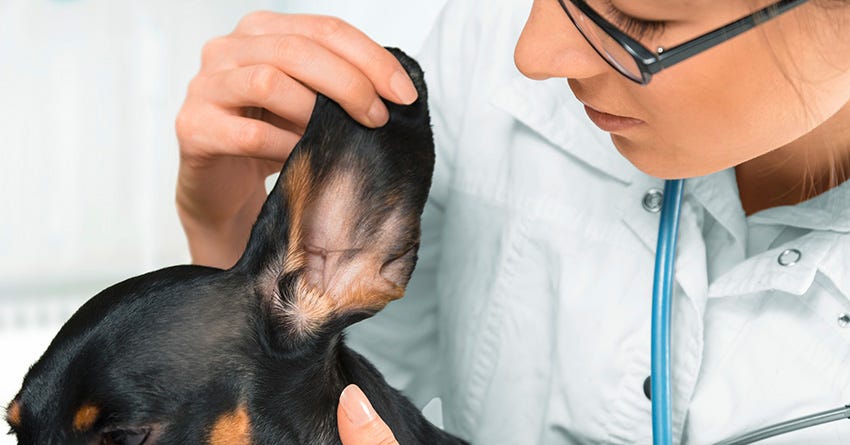Just how well is your canine companion able to hear? Are you aware of the means by which you can assess your dog’s hearing? Such are questions you may or may not consider pending the overall health of your dog and his current age. According to Starkey.com, one in five American adults suffer from some degree of hearing loss (over 36 million people). The statistics are worse for senior citizens, as one in three Americans over the age of 65 are hearing-challenged.
Typically, people take for granted their own hearing and that of their dogs until there is a problem. Once it's established that hearing is partially or completely lost, the ability for it to return is variable, depending on the cause. Most pets exhibit normal hearing throughout their lives, especially during the juvenile and adult life stages. Senior pets (those older than seven) and those having ear diseases, trauma, toxic exposure, glandular disorders, and cancer are most prone to becoming hearing-compromised.
How to tell if your dog is hearing compromised
Owners can perform a basic assessment of their dog’s hearing a couple of ways. First, closely observe of your pooch’s day to day habits. You may note that:- He doesn’t come greet you after being made aware of your return home once the garage or front door opens and closes.
- Your dog no longer responds to the calling of his name or other sounds to which he would typically turn his head or adjust his ear position
- He may only respond to your presence after feeling the vibrations of your footsteps on the floor.
- Your dog is no longer aware of other household canine or feline companions who now can seemingly sneak up and encroach upon his personal space.
Common causes of hearing loss in pets
Ear inflammation or infection Otitis, which is the technical term for inflammation of the ear, can have many underlying causes and contributing factors. Multiple classifications of otitis exist, including:- Externa - inflammation of the outer ear (ear flap and canal external to the ear drum)
- Media - inflammation of the middle ear (internal to the ear drum but separate from the labyrinth)
- Interna - inflammation of the inner ear (affecting the labyrinth, which include the semicircular canals and cochlea)
Basically, any time there’s a disease condition that reduces the diameter of the ear canal or blocks the normal movement of sound to the eardrum, hearing will be reduced. Otitis can be caused by inflammation secondary to atopic dermatitis (non-seasonal inhaled allergies), seasonal allergies, food allergy, flea allergy dermatitis, and others.
When there’s inflammation in the ear, the microenvironment changes and becomes friendlier to the growth of infectious organisms like bacteria and yeast. Ear mites are parasitic organisms that commonly affect juvenile dogs and those that live primarily outdoors or lack regular grooming and veterinary care. Toxic exposure Ototoxicity is hearing caused by toxic exposure. Certain antibiotics, such as aminoglycosides like Gentamicin, can damage hearing when taken orally, as an injection, or when put directly into the ear canal. Additionally, some diuretics, chemotherapeutics, and ear cleaning products can be ototoxic.
I recently had a patient go deaf in one ear and have his hearing temporarily reduced in his other ear after the appropriate use of a Gentamicin-based veterinary ear medication prescribed to treat Staphylococcal bacteria in his outer ear canal. As a result, I’ll no longer be putting such medications into my patient’s ears and have sought safer alternative medications and cleaning strategies.
Trauma Blunt trauma to the skull, neck, or other body parts can potentially contribute to hearing loss depending on the degree of damage incurred. Getting hit by a car, being kicked by a horse, tumbling down a flight of stairs, and other traumas can damage hearing.
Cancerous and non-cancerous masses take up space inside the ear canal or inner ear and can compromise hearing. Additionally, masses that grow inside the skull (intracranial) can press on the tissues surrounding the inner ear structures and can cause hearing loss. Ear canal masses may be seen via otoscopic exam. Intracranial masses are detected through advanced imaging techniques, like an MRI performed under general anesthesia. Glandular disorders Glandular disorders such as hypothyroidism (under-functioning thyroid gland) can contribute to improper nerve function due to lack of appropriate levels of circulating thyroid hormones.
Can diagnostic testing assess my dogs hearing?
Yes, the brainstem auditory evoked response (BAER) test can determine if your dog is or isn’t hearing. This test is more commonly available through veterinary neurologists than general practice veterinarians. The patient needs to be physically restrained and possibly mildly sedated and kept extremely still while sound impulses are directed into the ear. Electrodes placed under the skin in front of and behind the ear pick up the sounds if the cochlear nerve is stimulated and a waveform response can be visualized on the BAER’s screen. If a patient isn’t hearing, no waveform response will be seen. Unfortunately, BAER does not establish subtle degrees of hearing loss.What can I do to protect or promote my dog’s ability to hear?
Generally, maintaining the overall health of your dog and the cleanliness of his ear canal is the best way to promote normal hearing. Dogs having chronic ear inflammation or infection will be more prone to hearing loss, so make sure your pooch’s ear canals are kept clean. Ask your veterinarian for an ear cleaning demonstration and recommendations for an appropriate cleaning solution and frequency with which ear flushing should occur.
For most of my patients, I recommend cleaning every 7-30 days (weekly to monthly) or after any occasion water could enter the ear canal (bathing, swimming, etc.). If your dog is an adult or senior, then have his blood tested every 12 months or as directed by your veterinarian to look for hypothyroidism or other organ system changes that could contribute to nerve malfunction and hearing loss. If you suspect your dog has lost his hearing, immediately schedule an examination with your veterinarian. Seek a consultation with a veterinary neurologist to more deeply assess hearing loss if your dog’s issues cannot be fully addressed by your general practice veterinarian.

